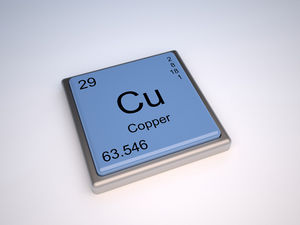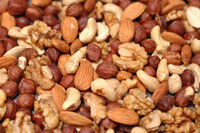Copper
| See Also | Minerals |
|---|
Copper is the third most plentiful essential trace mineral in the body (iron and zinc being the first two most abundant). It is involved in several important biochemical reactions in the body. The highest concentration of copper can be found in the brain and liver. [1].
Contents
Food Sources
The following foods have the highest concentration of copper. For a more expansive list on food sources of specific nutrients visit Health Canada's Dietary Reference Intakes for Elements or USDA's National Nutrient Database
Other food sources include:[2]
- grains: whole grains, beans, nuts,
- protein sources: oysters, other shell fish, organ meats (kidneys, liver)
- vegetables: Dark leafy greens, potatoes
- fruit: dried fruits such as prunes
- Other sources include: brazil nuts, soy lecithin, almonds, hazelnuts, walnuts, pecans, split peas, cocoa, black pepper, and yeast.
Uses
The following are the primary uses of copper. [1]
- Cardiovascular Disease (CVD): A deficiency in copper can lead to high cholesterol, heart muscle and arterial damage and increase mortality. In terms of arterial damage, deficiency may lead to aortic aneurysms. The integrity of the elastic fibers of the aorta are dependent on a copper-dependent enzyme; when copper is deficient, the aorta becomes too elastic and thus can balloon out (an aneurysm). Copper is used in the prevention of cardiovascular disease.
- Copper bracelets in arthritis: The copper in copper bracelets has been found to absorb through the skin and be chelated to another substance which then decreases inflammation and pain.
Deficiency Symptoms
Copper has many important functions in the body and therefore deficiency can lead to many signs and symptoms which include: [3] [1]
- Iron deficiency anemia: copper aids in proper iron absorption
- Poor collagen integrity: copper helps with cross-linking of collagen and elastin, therefore deficiency can lead to an aneurysm, osteoporosis, and bone and joint abnormalities.
- Hypothyroidism: copper is an important co-factor in the conversion of T4 to T3 which is the more potent thyroid hormone
- Other: increased LDL (bad) cholesterol and decrease HDL (good) cholesterol, brain disturbances, increased lipid peroxidation, and impaired immune function are associated with copper deficiency.
Causes of deficiency may include:[1]
- decreased intake: can be from low-copper infant formula, IV nutrition without added copper, malnutrition
- decreased absorption: can be from high dosage zinc or vitamin C supplementation, chronic antacid intake, chronic diarrhea, malabsorptive states, menke's kinky-hair syndrome
- increased loss: malabsorptive states, nephrotic syndrome, chelation therapy, burns
- increased requirement: pregnancy, lactation, prematurity
Excess Symptoms
Excesses in copper can be caused by a diet that is too low in zinc (copper and zinc are inversely concentrated in the body) or from high levels of copper in drinking water, typically from copper pipes. It can cause problems in pregnancy and is associated with post-partum psychosis, depression from birth control pills, and even cancer. [3] Copper intake of 10mg can induce nausea, and 60mg may cause vomiting.
- Adverse effects on zinc metabolism may also occur and represent the primary adverse effect of excessive copper levels. [4]
- Alpha lipoic acid may be effective in chelating excess amounts of copper.
Symptoms of moderate toxicity may include:
- weakness
- dizziness
- fainting
- headache (severe or continuing)
- burning sensation in the throat
- gastrointestinal disturbance
- loss of appetite
- vomiting
- excess salivation
- metallic taste in mouth
- dyspepsia
- epigastric pain
- painful urination
- low back pain
Symptoms of severe toxicity may include:
- hemolytic anemia
- hypertension
- liver damage
- jaundice
- hemochromatosis
- hemoglobinuria
- hematuria
- kidney failure
- coma
- and even death
Assessment Procedure
Best specimens to collect: [5]
- Urine - low level indicates a deficiency
- RBC - low level indicates a deficiency
- Hair Mineral Analysis - low level indicates a deficiency
Prescribing Considerations
- Copper is available in many different forms - complexed with sulfate, picolinate, gluconate, and amino acids. It is not clear which one is more beneficial.[1]
- The recommended dosages varies based on age and health status. To determine what your specific requirements are talk to your naturopathic doctor or other trained medical professional.
There is no specific RDA for copper. The following are considered safe and adequate ranges.
- Infants: 0.4-0.6mg (under 6 months); 0.6-0.7mg (6-12 months)
- Child: 0.7-1.0mg (1-3 years); 1.0-1.5mg (4-6 years); 1.5-2.5mg (7-10 years)
- Adolescent - Adult (11+ years): 1.5-3.0mg
Safety
Generally speaking, supplementation with copper should also occur if there has been testing to verify a deficiency.
- Children: Maximum safe dosage has not been determined for children and infants. Copper has been shown to be lethal in children at levels as low as 3.5g. The copper (and zinc) status of epileptic children taking valproate derivatives should be monitored.
- Adults: The tolerable upper limit of copper intake established by the U.S. National Institute of Medicine is 10mg/day (dietary and supplemental sources combined). In individuals who are copper replete or have copper overload, more than 3mg/day may contribute to further accumulation as the body can only eliminate 3mg/day.
- Pregnancy and Breastfeeding: Maximum safe dosage has not been determined. There have been no reports of teratogenicity or embryotoxicity in humans. However, animal studies indicate that deficiency or excess of copper can cause significant harm to a developing embryo.
- Adverse effects among specific populations: Copper intake exerts particular risk for individuals with Wilson's disease; severe liver or kidney disease (maximum safe dosage not determined); copper toxicity has been reported among people living in houses with copper pipes.
- Contraindications: biliary disease, cancer, heart bypass patients, liver disease, migraines, Wilson's Disease, during the course of anticopper therapies, individuals with chronic exposure to drinking water from copper pipes.
Drug Interactions
- Drug Interactions include:[4]
- Supportive or Beneficial:
- Ethambutol - Co-administration of copper with drug may reduce adverse effects, particularly on the optic nerve and related functions. Separate intake by 2 hours.
- Nonsteroidal Anti-inflammatory Drugs (NSAIDs) - Copper tends to complex with NSAIDs and might enhance their anti-inflammatory effects while reducing their ulcerogenic effects.
- Zidovudine (AZT) and Related Reverse-Transcriptase Inhibitor (Nucleoside) Antiretroviral Agents Co-administration of zinc and AZT can reduce adverse effects and enhance efficacy but extended therapy requires complement of copper to prevent adverse effects from zinc, thus providing a more comprehensive approach to supporting patients on AZT.
- Addresses Drug-Induced Deficiency:
- Allopurinol - Chelation of copper by allopurinol may help protect against cardiac damage during re-perfusion of the heart. Avoid copper before bypass surgery.
- Antacids - Drug can inhibit copper absorption and induce intestinal alkaline pH, which can precipitate dietary copper. Co-adminster with extended antacid use.
- Clofibrate and Related Fibrates - Drug may enhance copper metabolism and elevate hepatic copper levels and may reduce hypercholesterolemia particularly with compromised copper status. Co-administer as appropriate.
- Famotidine and Related H2 Receptor Antagonists - Drug can interfere with the acidic gastric environment optimal for copper absorption. Separate intake by at least 2 hours.
- Valproic Acid and Related Anticonvulsant Medications - Drug may induce copper deficiency and disrupt copper homeostasis. Monitor copper and zinc; copper administration is warranted with deficiency.
- Contraindicated:
- Estrogens, Progestins, and Estrogen-Progestin Combinations (Oral Contraceptives, Hormone Replacement Therapy) - Exogenous female hormones, especially progestins, may enhance coper absorption and elevate copper levels. Avoid concomitant copper supplementation unless risk of depletion.
- Penicillamine and Related Chelating Agents - These agents are designed to bind copper and limit its absorption and accumulation. Limit dietary and avoid supplemental copper intake.
- Other:
- Cimetidine - There is consistent evidence that cimetidine binds minerals such as copper and iron. Individuals taking copper supplements are advised to allow at least a 2 hour interval to pass before taking cimetidine.
- Ciprofloxacin - Copper and other minerals can bind the drug and reduce its absorption. Separate intake by at least 2 hours.
Nutrient Interactions
- Nutrient Interactions include [4]
- Iron - Copper stimulate intestinal absorption and improves utilization of iron, whereas iron can inhibit copper absorption.
- Molybdenum - Administration of tetrathiomolybdate, which contains molybdenum at the centre of four chelating sulfhydryl groups, can serve as an effective copper-chelating agent with signficant fewer adverse effects than most conventional copper chelators.
- Vitamin C - intake at pharmacological doses for extended periods can lead to a depletion of copper in the absence of copper supplementation.
- Zinc - Zinc interferes with copper absorption. Copper should be supplemented unless zinc is being used as an anti-copper agent and in those with Wilson's disease. Copper should be taken at least 2 hours after zinc.
References
- ↑ 1.0 1.1 1.2 1.3 1.4 Murray Michael T (2005) Encyclopedia of Nutritional Supplements, The Essential Guide for Improving Your Health Naturally, Prima Publishing
- ↑ Medlineplus [1]
- ↑ 3.0 3.1 Hoffer Abram, Prousky Jonathan (2006) Naturopathic Nutrition, A Guide to Nutrient-Rich Food & Nutritional Supplements for Optimum Health, CCNM Press
- ↑ 4.0 4.1 4.2 Stargrove Mitchell Bebell, Treasure Jonathan, McKee Dwight L (2008) Herb, Nutrient, and Drug Interactions, Clinical Implications and Therapeutic Strategies. Mosby
- ↑ Bralley J Alexander and Lord Richard S (2005) Laboratory Evaluations in Molecular Medicine, Nutrients, Toxicants, and Cell Regulators Institute for Advances in Molecular Medince, GA


